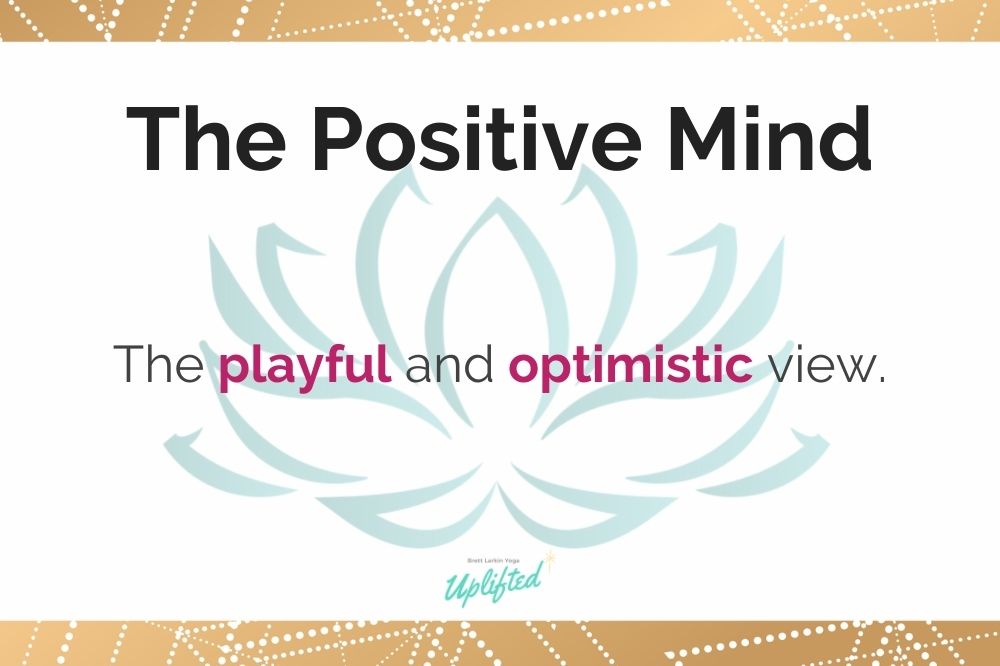⚠️ Disclaimer: this article does not suggest that positivity will solve all of your problems. The Positive Mind ≠ a positive mindset.
Wait.. what? Aren’t yogis supposed to be, like, eternally positive?
Hear me out.
In the history of, umm, the universe, has anyone reacted well when told to just lighten up? Have you? This approach invalidates human experience – and it’s not what we’re focusing on today.
Through the teachings of Kundalini yoga, we’re taught that we actually have three mental bodies. You can think of them like lenses. We have a Positive Mind, a Negative Mind, and a Neutral Mind, through each perceiving different aspects of the world around us.
In this article, we’ll look at the characteristics of the Positive Mind, how to know when it’s out of balance, and what to do to bring it back to harmony with our other mental bodies.
What is the Positive Mind in Yoga?
The positive mind is the third body in the described ten light bodies of yoga in Kundalini yoga. much like it sounds, this is your ability to see the good in life. Sometimes referred to as the projective mind, it is deeply connected to the positive essence of life. When your positive mind is healthy, you feel expansive and capable to draw new resources and energies in. While it may sound like the perfect form of consciousness, it needs the other two mental bodies for proper balance.
- The Negative Mind (Second Body): This is your ability to set boundaries, discern danger, and protect yourself. Without the negative mind to balance it out, the projective mind can sometimes make foolish choices and be overly optimistic to the point of delusion.
- The Neutral Mind (Fourth Body): The neutral mind is your mind in a meditative and balanced state. Because of this, it’s often referred to as the meditative mind. This is the space of harmony between the negative and the positive mind. When strengthened properly, the neutral mind will take input from the other two mental bodies in order to make the wisest decision.
It’s taught that we all lean towards either being more protective (negative mind) or projective (positive mind.) Ideally, we are able to listen to both in the process of finding balance in the meditative mind.
The 10 Bodies of Yoga
As we’ve mentioned, the positive mind is actually just one of the ten bodies of yoga in Kundalini yoga. We’ll briefly review them here, but check out the main article for an in-depth review.
The ten bodies of yoga are broken down into three categories: the physical body, three mental bodies, and six energy bodies.
- Soul Body: connecting to your inner wisdom
- Negative Mind: learning to protect yourself
- Positive Mind: having a playful & optimistic view
- Neutral Mind: accessing your intuitive senses & compassion
- Physical Body: creating a connection between heaven and earth
- Arcline: tapping into your third eye to focus & meditate
- Aura: the electromagnetic field of energy surrounding your fifth body
- Pranic Body: the breath that energizes the physical and the soul body
- Subtle Body: seeing beyond external reality into the nuances of life
- Radiant Body: the union of your soul body and your radiance
As you can see, the positive mind is just one piece of a vastly complex and magical system of energies that makes up who you are as a human being!

The Positive Mind vs. a Positive Mindset
In the West, we often talk about positive thinking as a “mindset.” It’s important here to note the difference between the positive mind and a positive mindset. In modern cultures, we’re often sooo hyper-focused on positivity that we invalidate our own and others’ real emotions in crises, contribute to unhealthy workplace cultures that brush serious problems under the carpet, and basically contribute to the emotional conflict-zone that is America today. Yep, yogis, it’s called toxic positivity; and it has nothing to do with the positive mind in yoga’s 10 bodies.
Western positivity is also often focused on external things, rather than internal conditions. We receive messages All. Of. The. Time that try to convince us “If you buy this new and fancy thing – all your problems will go away!”, or “If you just drink one beer, you will feel happier and more fulfilled!” Rather than hyper-focusing on only the good, yoga’s positive mind invites you to work from the inside out, celebrating your hopeful behaviors and leaving unrealistic expectations behind.
Characteristics of The Positive Mind
Affirmation: I allow myself to be hopeful, aspire to goodness, and experience the sweetness of life.
Qualities: A strong and thriving positive mind is noticeable with certain qualities. You can usually sense those with a strong positive mind, as they are magnetic, attracting awareness and life like a candle flame in the darkness. This is manifest in:
- A positive outlook & an emphasis on equality
- Infectious enthusiasm
- A trusting and hopeful disposition
- Energetic projection
- A strong sense of humor
When your positive mind is strong, you’re able to be a beacon of hope for others. You not only create positivity for your own self, but you elevate others through your infectious joy and enthusiasm. You are able to go with the flow, and you somehow seem to always be at the right place at the right time. When your positive mind is flowing and in balance, manifestations will happen for you when and how they should.
Through this positive, expansive mind you feel open to all the possibilities of life. Not only that, but you’re able to welcome them into your life with grace and humility. Through this strong 3rd body, you feel naturally playful and optimistic. And with this natural charisma, your communication is strong and direct.

Balancing the Positive Mind (Third Body)
When we talked about the mental bodies, we mentioned the need for balance. If the positive mind is overly active or deficient, you’ll begin to notice signs.
Signs of Balance: A balanced 3rd body is joyous but humble, optimistic yet wise. A third body positive mind will also manifest as:
- Effortless charisma
- Natural playfulness
- Optimism & good sense of humor
- The ability to inspire others
- Strong self esteem
Symptoms of Imbalance: This 3rd body can either be overly active or deficient. Both will have different symptoms of imbalance. This include:
- The inability to consider risks
- Overly positive to the point of delusion
- An overwhelm of negative thoughts
- Fear of expressing your voice and your power
- An influx of negative thoughts that overwhelm you
If you feel signs of imbalance within your positive mind, there are practices you can do to regain harmony.
How to Channel the Positive Mind
Strengthen Your Solar Plexus Chakra
The solar plexus chakra is located at your navel point and is our seat of personal power and outward expression. In this way, it’s strongly connected to a healthy positive mind. Try this Solar Plexus meditation for healing and balancing. There are also many practices in the kundalini yoga lineage that will help you strengthen your solar plexus.
Use Positive Affirmations
If you feel like your positive mind may be weak, you can strengthen it by utilizing positive affirmations on a regular basis. This will help to quiet the negative mind. Use whicher affirmations feel natural and true to you. Working on your chakra balance? Focus on the affirmations that correspond to the energy centers that need some TLC.
Set Clear Boundaries
If you feel like your positive mind is too strong, it might be time to start setting some boundaries. This can be a lifelong practice, so start by identifying some people you know who are good at protecting themselves. If it’s someone you know personally, you can reach out for support. If you don’t know them, then journal about how they inspire you, what you admire about them and how you might be able to embody some of this strength on your own.
Next Steps
- Love Kundalini? Refine your tune in (the Adi Mantra) with me in this free chanting masterclass.
- Experience my Kundalini Dance Party and elevate your mood in 8 minutes.
- Enroll in my Kundalini Demystified training course. Let’s demystify the “mystery” of this ancient science and INSTANTLY reap the benefits!
Get 3 Free Training Vidoes from our Kundalini University Experience & Certification Program

YOU MIGHT ALSO LIKE
- Kundalini for Feminine Energy: Ignite Your Creative Power and Passion
- Mastering the Sufi Grind: Benefits and Techniques for All Levels
- Kundalini Yoga for Chakras: An Uplifted Guide to Energy Balance
- Discover the Benefits of the Gobinday Mukunday Mantra for Well-Being
- Nabhi Kriya: Ignite Your Inner Fire and Personal Power
- Ek Ong Kar Sat Gur Prasad: Kundalini Mantra For Manifestation
- Tantric Har Chant: How It Fuels Prosperity and Inner Power
- Powerful Mantra for Protection Against Negative Energy and Harm
- The Power of Humee Hum Brahm Hum Mantra for Connection and Healing
- The Sa Re Sa Sa Mantra: Connecting Breath, Light, and Creativity
- What Is The Ajai Alai Mantra In Kundalini Yoga?
- What Is Sat Nam Rasayan? How And When To Practice
- The Meaning Of Ang Sang Wahe Guru Mantra in Kundalini Yoga
- Kundalini Yoga: How To Start A 40 Day Kriya
- Energetic Cord Cutting Ritual For Divine Feminine Energy
Get 3 Free Training Vidoes from our Kundalini University Experience & Certification Program













